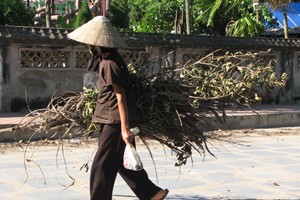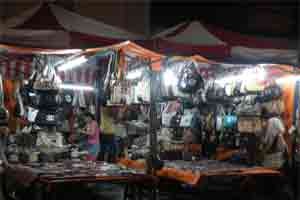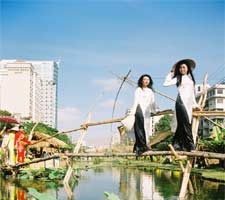For over 15 years, Vo Cong Khanh, a renowned actor of “hat boi,” and his family in Vinh Long Province, has made hundreds of splendid historical costumes for the “queens” and “kings” of hat boi troupes throughout the Mekong Delta.

According to Khanh, Hat boi or “hat tuong,” or sometimes known in the South as “hat bo”, is an embryonic form of classical Vietnamese adapted from Chinese opera. Originated in 13th centry in Tran Dynasty (1225-1400), Hat Boi was long supported by kings and provincial mandarins as a court art and performed for popular audiences as well, especially in central provinces. Making hat boi costumes is not only a way to make a living for his family, said Khanh, but also a way to revive hat boi, a dwindling folk art.
“My father was a hat boi actor and his troupe went on tour everywhere in the region,” Khanh recalled. “From time to time, my father let me go with him and the owner of the troupe allowed me to play minor or walk-on characters as I was just an elementary pupil at the time.”
“Like other hat boi troupes, my father’s regularly performed at temples in villages,” added Khanh. “In the early 18th century, each province in the Mekong Delta had hundreds of temples. According to local custom, each temple organized a ceremony every three years on a date set by a temple’s board of administration to worship for the nation’s peace and prosperity. A hat boi troupe was invited first to help with the rites and then to serve the local people’s need for entertainment. A tour trip lasted for at least a two weeks. Many times, we were invited to perform at a temple for a month.”

Khanh said that just 50 years ago, hat boi was a folk art that dominated stages in the South. A troupe traveled from one place to another by wooden barge or sampan on the Mekong River. The barge transported the music instruments and decorations for the stage while the sampans carried the actors and actresses and their belongings. Together they traveled to villages in remote areas in the delta to offer memorable performances to local people. The performance sites were always temples, in other words, temples were very dear to the hearts of the local residents thanks to hat boi.
“That was a glorious time for this kind of folk art,” Khanh added. “Since the news about the arrival of a troupe at a village was announced to the local people and those in neighboring areas a month ago, people of nearby villages loaded rice, foods and even their mosquito-nets and blankets on their boats or sampans, sailed to the temple where the performance was going to take place to wait for the troupe. They were going to have a time of enjoyment, without worrying about work.

“The temple was packed with audience members,” said Khanh. “Villagers wore fine clothes, clothes that they worn one on important events such as Tết. The temple was not only turned into an entertainment place, but also a dating place for young people.”
“Every night we performed a different opera, each hat boi opera had three episodes,” Khanh recalled. “The two first might have miserable scenes about wartime, but the last one had to have a happy ending. For example, the war ended and people lived in peace and happiness.”
Since the early 20th century, cải lương, a more modern form of opera popular in the South, movies and music have gradually taken place of hat boi on the stage. As a result, hat boi sunk into oblivion. Many hat boi actors and actresses have now sought another way to make a living. From time to time, they appear on stage in effort to reintroduce the dwindling folk art to the mass, especially to younger generations.

Two decades ago, said Khanh, owners of once- flourishing hat boi troupes always felt proud to spend large amount of money on splendorous costumes for their actors and actresses so they went as far as to Ho Chi Minh City for shopping. Then the very hard time came for all hat boi troupés when they faced an increasing loss of audiences. In such a situation, buying expensive costumes was no longer a trivial matter for hat boi troupes and they had little choice but to borrow costumes from one another.
“Sometimes I had to wear a worn-out gown – imagine, a king in a worn-out gown-- to go to the stage and I felt so sad, so I decided to make costumes for hat boi and cai luong troupes in the Mekong Delta at lower prices,” Khanh added. “As a ‘king or a ‘queen,’ you should not dress in a worn-out gown forever, should you?”

It was a tale of struggle for Khanh and his family at the outset as the job required a lot of time, patience and skill. For the decoration of a gown for a king or a queen, they had to embroider all the meticulous details of patterns of dragons or phoenixes on them by hand and then attached countless of tiny glittering beads also by hand on such embroidered patterns to make it look more splendorous. Khanh said that it usually takes his family a week or more to finish such a gown.
Like other hat boi actors and actresses, Khanh always his best to create a brighter future for hat boi. Last year, five actors and actresses of Vinh Long’s Dong Thinh Hat Boi Troupe were invited to perform in the Smithsonian Folklife Festival in the U.S. Their performance received a tremendous ovation from audiences who were local residence and overseas Vietnamese. “This good news brought tears to us all,” said Khanh.
























